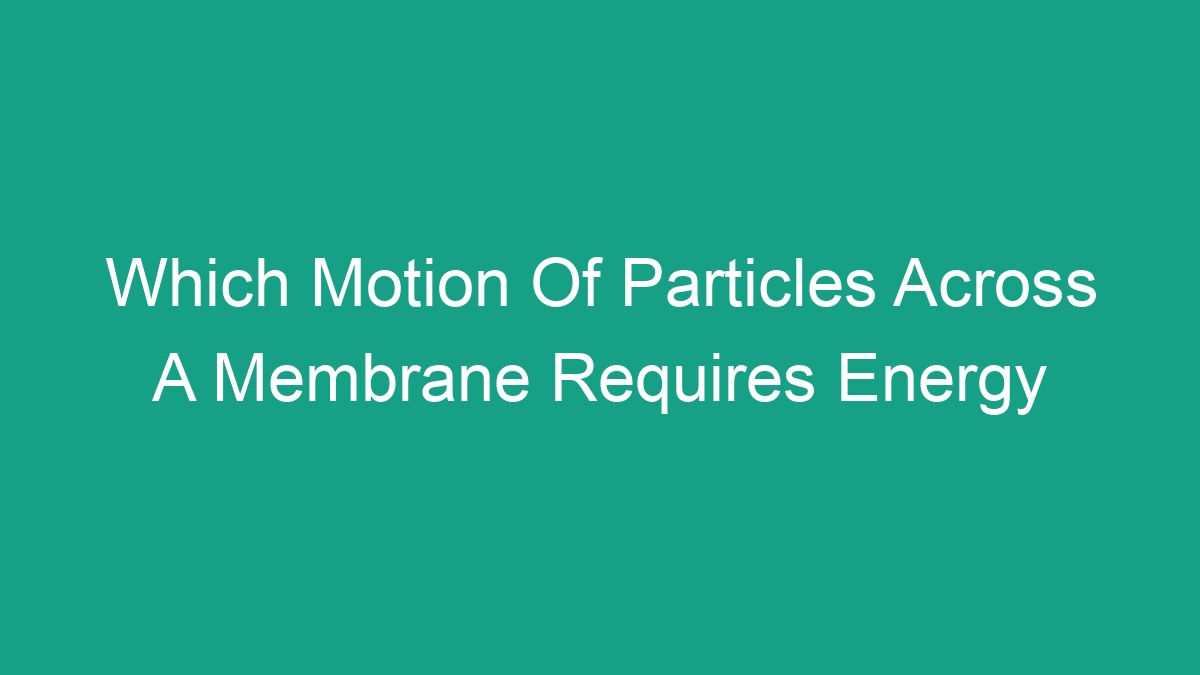
When we talk about the movement of particles across a membrane, we are often referring to the process of passive or active transport. Passive transport does not require energy expenditure, while active transport requires energy in the form of ATP. The motion of particles across a membrane involving energy expenditure includes processes such as active transport, endocytosis, and exocytosis.
Active Transport
Active transport is a process that requires the expenditure of energy to move molecules across a cell membrane, typically against their concentration gradient. This means that molecules are moved from an area of lower concentration to an area of higher concentration. The primary source of energy for active transport is ATP, the energy currency of the cell.
In active transport, specialized proteins called carrier proteins are used to transport molecules across the cell membrane. These carrier proteins bind to specific molecules, undergo a change in shape, and then release the molecules on the other side of the membrane. This process is essential for the movement of ions such as sodium, potassium, calcium, and hydrogen across cell membranes.
Examples of active transport include the sodium-potassium pump, which actively transports sodium ions out of the cell and potassium ions into the cell, and the calcium pump, which transports calcium ions against their concentration gradient.
Endocytosis
Endocytosis is a process by which cells take in molecules or particles by engulfing them in a vesicle formed from the cell membrane. This process requires energy and is essential for the uptake of substances such as nutrients, signaling molecules, and pathogens. There are several types of endocytosis, including phagocytosis, pinocytosis, and receptor-mediated endocytosis.
Phagocytosis involves the engulfment of large particles such as bacteria or cellular debris, while pinocytosis involves the uptake of smaller molecules and particles in fluid form. Receptor-mediated endocytosis is a highly specific process that involves the binding of ligands to receptors on the cell membrane, triggering the formation of vesicles containing the ligands for internalization.
Endocytosis requires energy because it involves the movement of molecules or particles against a concentration gradient, as well as the restructuring of the cell membrane to form vesicles. ATP is utilized to power the necessary changes in the cell membrane and facilitate the movement of substances into the cell.
Exocytosis
Exocytosis is the process by which cells release molecules or particles from within the cell to the external environment. This can include the secretion of hormones, neurotransmitters, digestive enzymes, or waste products. Exocytosis also requires energy, as it involves the fusion of vesicles with the cell membrane to release their contents.
During exocytosis, vesicles containing the molecules to be released move towards the cell membrane and fuse with it, allowing the contents of the vesicles to be expelled from the cell. This process requires the expenditure of energy to facilitate the movement and fusion of the vesicles with the cell membrane.
Exocytosis is crucial for the proper functioning of cells, as it allows for the release of signaling molecules and the removal of waste products. It also plays a significant role in processes such as neurotransmission and hormone secretion.
Comparison of Energy Requirement
When comparing the energy requirements of the different processes involved in the motion of particles across a membrane, it is evident that active transport, endocytosis, and exocytosis all require energy expenditure. The primary source of energy for these processes is ATP, which is produced by the cell’s mitochondria through cellular respiration.
| Process | Energy Requirement |
|---|---|
| Active Transport | Requires energy in the form of ATP to move molecules against their concentration gradient |
| Endocytosis | Requires energy for the restructuring of the cell membrane and the formation of vesicles |
| Exocytosis | Requires energy for the movement and fusion of vesicles with the cell membrane |
It is important to note that while all three processes require energy, they serve distinct functions in the regulation of cellular processes. Active transport maintains the concentration gradients of ions and molecules across the cell membrane, endocytosis facilitates the uptake of nutrients and signaling molecules, and exocytosis allows for the release of substances from within the cell.
Conclusion
The motion of particles across a membrane that requires energy includes processes such as active transport, endocytosis, and exocytosis. These processes are essential for the proper functioning of cells and play crucial roles in maintaining cellular homeostasis, communication, and waste removal.
Understanding the energy requirements of these processes provides valuable insight into the fundamental mechanisms that govern cellular function. By utilizing ATP as a source of energy, cells are able to orchestrate the movement of molecules across the cell membrane in a controlled and regulated manner.
As our knowledge of cellular biology continues to expand, further research into the energetics of membrane transport processes will undoubtedly yield new insights and potential therapeutic targets for various medical conditions.


